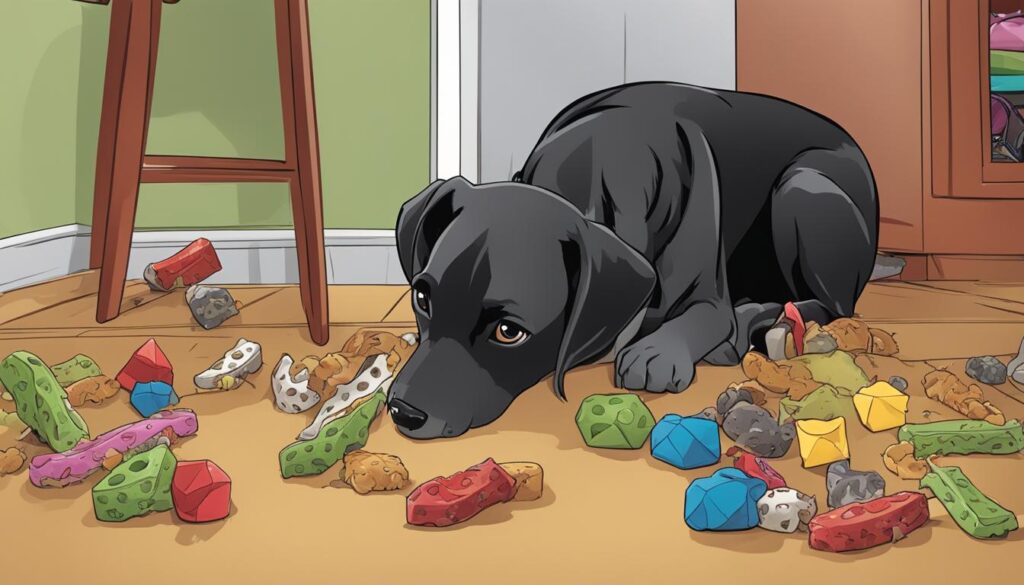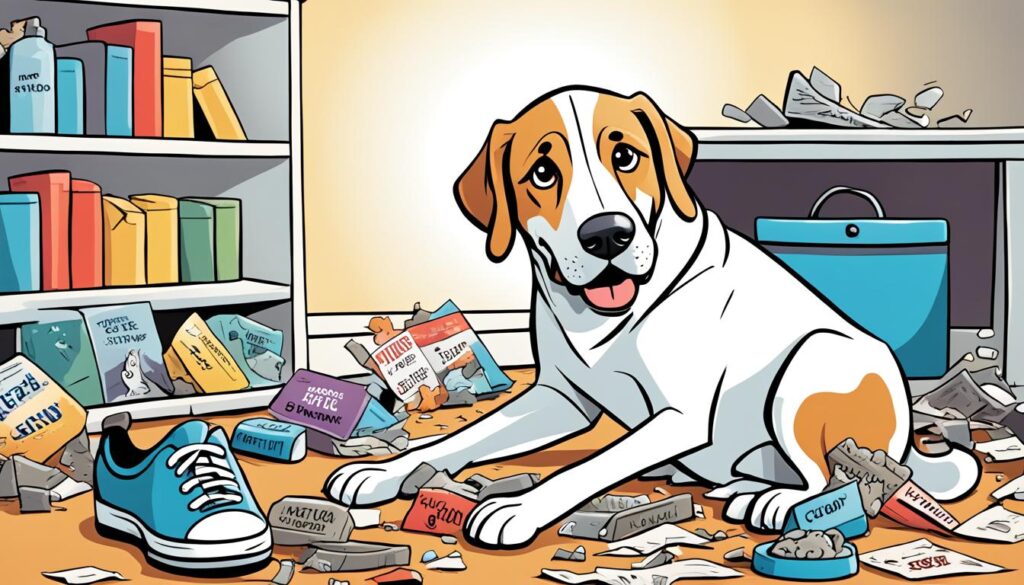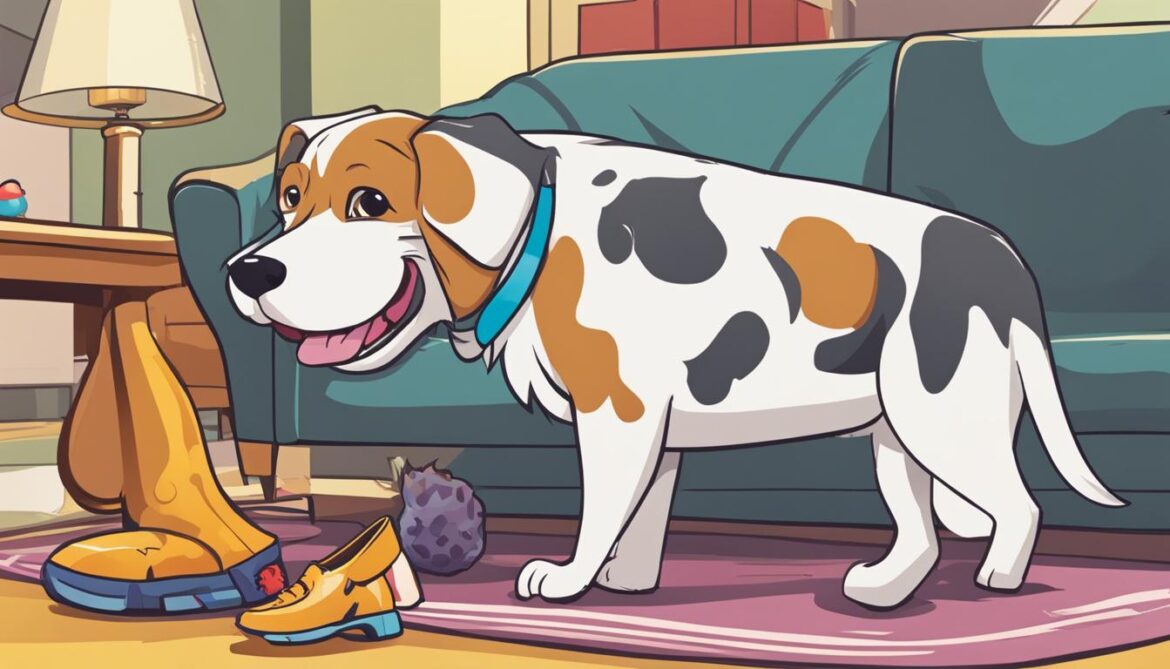Imagine coming home after a long day, looking forward to some much-needed relaxation. As you open the door, you’re greeted with a scene of destruction. Your favorite pair of shoes lies torn apart, the couch cushions are in disarray, and remnants of your once-pristine belongings are scattered across the floor. The culprit? Your beloved furry friend, with an innocent look on their face and a guilty tail wagging in the background.
We’ve all been there, frustrated and at a loss for how to stop our dogs from chewing everything in sight. But worry not, because help is on the way. In this article, we will provide you with effective strategies and proven techniques to curb your dog’s chewing habits once and for all.
From understanding the root causes of chewing behavior to implementing preventative measures, we will equip you with the knowledge and tools necessary to create a chew-free environment for your furry friend. So, say goodbye to shredded furniture and hello to a harmonious household.
Key Takeaways:
- Understand the reasons behind your dog’s chewing behavior.
- Implement proactive prevention techniques and training methods.
- Create a dog-friendly environment to discourage chewing.
- Learn effective redirection and distraction techniques.
- With patience and consistency, you can stop your dog’s chewing habits.
Understanding Chewing Behavior in Dogs
Before diving into solutions, it is important to understand why dogs chew in the first place. By gaining insight into the common reasons behind chewing behavior, you can tailor your approach to stop your dog from chewing effectively.
Dogs may chew for various reasons, including:
- Teething: Just like babies, dogs go through a teething phase during which they experience discomfort in their gums. Chewing helps alleviate the pain and discomfort.
- Boredom: Dogs require mental and physical stimulation. When they lack stimulation, they may resort to chewing as a way to occupy themselves.
- Anxiety: Dogs may chew as a coping mechanism for anxiety or stress. It provides a sense of comfort and helps them alleviate their nervousness.
- Exploration: Puppies and curious dogs often explore the world by using their mouths. Chewing allows them to discover new textures, tastes, and smells.
To effectively address your dog’s chewing behavior, it’s essential to identify the specific underlying cause. This knowledge will help you implement the most appropriate strategies and techniques to prevent your dog from chewing.

“Understanding why dogs chew is essential in order to effectively address the behavior.”
Prevention Techniques and Training Methods
Prevention is key when it comes to curbing dog chewing habits. By implementing proactive techniques and training methods, you can effectively discourage your dog from chewing on inappropriate objects. In this section, we will explore a range of effective strategies to prevent dog chewing and promote positive behavior.
1. Provide appropriate chew toys
Offering your dog a variety of safe and durable chew toys is essential. These toys will satisfy your dog’s natural urge to chew and help redirect their chewing behavior away from your belongings. Choose toys made specifically for chewing, such as rubber or nylon toys, and avoid ones that resemble household items to prevent confusing your dog.
2. Use deterrent sprays
Deterrent sprays can be effective in preventing your dog from chewing on furniture, shoes, and other forbidden items. These sprays have unpleasant tastes or odors that discourage dogs from mouthing or chewing. Apply the deterrent spray on the items you want to protect, and the strong scent or bitter taste will deter your dog from chewing on them.
3. Incorporate obedience training
Obedience training plays a crucial role in preventing unwanted chewing behavior. Teach your dog basic commands such as “leave it” and “drop it” to redirect their attention when they show interest in chewing on inappropriate objects. Consistency and positive reinforcement are key to successful training.
4. Use positive reinforcement
Positive reinforcement is an effective training method that rewards your dog for good behavior. When your dog refrains from chewing on inappropriate objects, praise and reward them with treats, toys, or verbal affection. This positive reinforcement strengthens the connection between good behavior and rewards, encouraging your dog to continue making the right choices.
5. Create a designated chewing area
Designating a specific area for your dog to chew can help redirect their chewing behavior. Set up a comfortable spot with appropriate chew toys and encourage your dog to use this space. This way, they will learn that chewing is acceptable in that area and are more likely to leave other items untouched.
“Prevention is the best medicine when it comes to stopping your dog’s chewing habits. By incorporating training techniques and providing appropriate outlets for chewing, you can create a chew-free environment for your furry friend.” – Dr. Jane Miller, Animal Behavior Specialist
| Prevention Technique | Benefits |
|---|---|
| Provide appropriate chew toys | – Satisfies natural chewing instincts – Reduces destructive chewing – Redirects attention away from inappropriate objects |
| Use deterrent sprays | – Discourages chewing on forbidden items – Creates unpleasant taste or scent association |
| Incorporate obedience training | – Reduces impulse to chew – Develops good behavior habits – Enables redirection and control |
| Use positive reinforcement | – Rewards desired behavior – Strengthens association between good behavior and rewards |
| Create a designated chewing area | – Provides a safe space for chewing – Redirects focus away from household items |
Environmental Management Tips
Creating a dog-friendly environment is crucial in preventing destructive chewing. By implementing these practical tips, you can safeguard your belongings and protect your dog from potential hazards. Follow these best methods to curb dog chewing:
Dog-Proof Your Home
Take proactive measures to remove items that may tempt your dog to chew. Keep shoes, socks, and other personal belongings in closed closets or drawers. Secure electrical cords and loose wires out of reach, as they can present a danger if chewed on. Use baby gates or barriers to restrict access to certain areas of your home until your dog’s chewing behavior is effectively managed.
Designated Play Areas
Establish designated play areas for your dog, equipped with appropriate chew toys and interactive games. This will help redirect your dog’s natural chewing instincts towards acceptable objects. Place toys and puzzles strategically around the area to keep your dog engaged and entertained.
Utilize Crate Training
Introduce crate training as a safe and comforting space for your dog. Crates can serve as a cozy retreat and also act as a prevention tool when you cannot supervise your dog. Ensure the crate is appropriately sized and equipped with comfortable bedding, water, and enrichment toys to keep your dog occupied.
Provide Mental Stimulation
Dogs often chew out of boredom or excess energy. Engage your dog’s mind by incorporating mental stimulation activities into their daily routine. Interactive puzzle toys and treat-dispensing games are effective in redirecting their focus and providing mental engagement.
Use Bitter-Tasting Sprays
Apply bitter-tasting sprays to objects that your dog has shown a particular fondness for chewing. These sprays emit a strong taste that will discourage your dog from further destructive chewing. Ensure the sprays are pet-safe and follow the manufacturer’s instructions.
By implementing these environmental management tips, you can create a safe and chew-free environment for your dog. Remember to combine these strategies with the training and prevention techniques outlined in earlier sections for optimal results.

| Dog-Friendly Environment Tips | Description |
|---|---|
| Dog-Proof Your Home | Remove tempting items and secure potential hazards. |
| Designated Play Areas | Create spaces with appropriate chew toys for redirection. |
| Utilize Crate Training | Introduce a safe and comfortable crate as a prevention tool. |
| Provide Mental Stimulation | Engage your dog’s mind with interactive games and puzzles. |
| Use Bitter-Tasting Sprays | Apply sprays to deter chewing on specific objects. |
Redirection and Distraction Techniques
Sometimes, despite your best efforts, dogs may still engage in chewing behavior. To prevent your furry friend from targeting inappropriate items, it is important to redirect their attention and provide alternative chewing options. In this section, we will explore effective techniques to redirect and distract your dog, keeping them engaged and satisfied.
1. Puzzle Toys
Puzzle toys are a great way to stimulate your dog’s mind and redirect their chewing instincts. These toys are designed to challenge and entertain your dog, providing mental stimulation while satisfying their need to chew. Fill the toy with treats or kibble to encourage your dog’s interest and keep them occupied. Not only will puzzle toys divert their attention from destructive chewing, but they also promote problem-solving skills and prevent boredom.
2. Interactive Play
Interactive play sessions are an excellent way to redirect your dog’s energy and provide a positive outlet for their chewing behavior. Engage in games such as fetch, tug-of-war, or hide-and-seek to channel their instincts into a more appropriate activity. By actively participating in playtime, you create a bond with your dog and establish yourself as their preferred chewing partner. Remember to use durable toys designed for interactive play to avoid accidental swallowing or choking hazards.
3. Mental Stimulation
Mental stimulation is essential for preventing boredom and reducing destructive chewing tendencies. Incorporate activities that challenge your dog’s intellect, such as obedience training, scent games, or food puzzles. Teaching your dog new commands and tricks not only diverts their attention but also provides them with mental satisfaction and a sense of accomplishment. Consider enrolling in obedience classes or engaging in DIY training sessions to keep your dog mentally engaged and less likely to resort to chewing.
“Redirecting your dog’s attention with puzzle toys, interactive play, and mental stimulation can effectively curb destructive chewing habits.” – Dr. Michelle Stevens, Veterinarian
Implementing redirection and distraction techniques is an important part of dog chewing prevention. By providing engaging alternatives, you can redirect your dog’s instincts and keep them away from inappropriate chewing targets. The combination of puzzle toys, interactive play, and mental stimulation will not only satisfy their chewing needs but also prevent boredom and promote a happy, well-behaved dog.
Conclusion
In conclusion, stopping your dog’s chewing habits requires a comprehensive approach that combines prevention, training, and redirection techniques. By implementing these strategies, you can effectively manage and ultimately eliminate destructive chewing behavior.
Firstly, prevention is crucial to creating a chew-free environment. Provide your dog with appropriate chew toys and use deterrent sprays to discourage them from chewing on inappropriate items. Additionally, incorporating obedience training and positive reinforcement can help redirect their focus away from destructive chewing habits.
Furthermore, environmental management plays a key role in preventing chewing behavior. Dog-proof your home by keeping valuable items out of reach and secure hazardous substances. Utilize crate training and designated play areas to create a safe space for your dog to engage in appropriate chewing activities.
Lastly, in instances where your dog still engages in chewing despite preventative measures, redirection and distraction techniques can be effective. Invest in puzzle toys and engage in interactive play to keep their minds stimulated and satisfy their natural chewing instincts.
